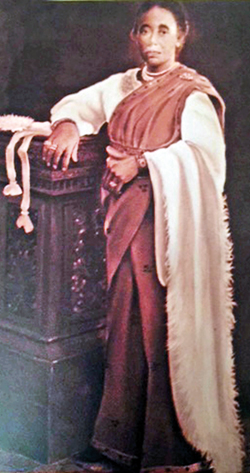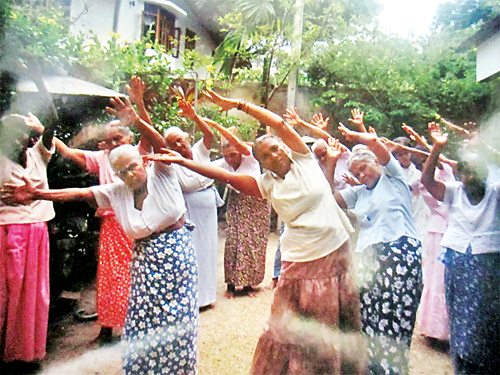100 years ago a Home opened its doors to the forgotten women
On any given day, a home with a sprawling garden in the heart of Colombo’s Kollupitiya would bustle with activity.
The gates would open to welcome the poorest of the poor, essentially elderly women, who would not only be fed but also bathed and clothed by the retainers of this residence.

Mallika Hewavitarne: Her legacy lives on
In attendance and presiding over the arrangements, looking into every little detail would be the matriarch of the family, Mrs. Mallika Hewavitarne, the wife of Mudliyar Don Carolis Hewavitarne.
Walking around the compound, with a kind word here and a gentle pat there, Mrs. Hewavitarne got an insight into the tragic plight of the many destitute women in the city.
It was a pitiful sight. Most of the “visitors” had no fixed abode. There seemed no one to care for them. Moved by their plight, Mrs. Hewavitarne realized that something needed to be done and turned to her doctor-son. She asked him to find a roof under which these hapless women could be sheltered. A permanent Home for the Aged was discussed and so was born the Mallika Anatha Nivasa Samithiya, a century ago, on October 9, 1920 in the dark days of colonial rule.
While Mrs. Hewavitarne’s husband pioneered what is considered Sri Lanka’s oldest and largest specialty furniture manufacturer, retailer and exporter, H. Don Carolis & Sons, and was a Founder of the Vidyodaya Pirivena, an early Buddhist monastic college for the training of monks among many other philanthropic deeds, her famous son Don David, the Anagarika Dharmapala, was spearheading a non-violent nationalist movement locally, campaigning for the rights of Buddhists in India and spreading the Buddha’s Doctrine in faraway lands.
Dr. Charles Alwis Hewavitarne was the third son of the Hewavitarne clan who fulfilled his mother’s wish. Two of her sons had died–Edmund (in a British jail in Jaffna at 45 years) and Simon (at age 37). An activist in his own right, Dr. C.A., a physician and leading member of the Temperance Movement, was General Secretary of the Maha Bodhi Society established by the Anagarika and was at the forefront of the Ceylon National Congress.
It was Dr. C.A. Hewavitarne who dug deep into his pockets and purchased a one-acre block of land with a house, not in a remote corner of the country but down Visakha Road in Bambalapitiya, and set up a Home for Elderly Destitute Women in 1920. By February 27, 1921, the first two destitute women were enjoying the security of the spruced up building. The all-female Founder Committee of the samithiya was formed under the Presidency of Mrs. Mallika Hewavitarne with several leading ladies from Colombo’s better-off families rallying round. Mrs. Laura de Mel & Mrs. E.L. Wijegunawardena were the Secretaries; Lady Evadne de Silva, the Treasurer; and Mrs. C.A. Hewavitarne, Mrs. Edmund Hewavitarne, Mrs. D.B. Jayathileke, Mrs. Nelli Gunasekera, Mrs. M.J.C. Fernando, Mrs. W.A. De Silva, Mrs. A.P. Fernando, Mrs. E.O. de Fonseka, Miss Gunasekera, Mrs. D.C.S. Jayasinghe, Miss de Mel, Mrs. F.R. Senanayake, Mrs. A.E. de Silva (Senior), Mrs. Newton A. de Silva, Mrs. S.N. Moonesinghe, Mrs. H.M. Gunasekera, Miss Vimala Hewavitarne, Miss Sumana Hewavitarne & Miss Abayaratne formed the committee.

Pioneers: Mrs Hewavitarne (seated centre) with members of the founding committee
The rest is history, with the initial house gradually being expanded with the ‘Laura de Mel Hall’ in 1922; the ‘Neil Hewavitarne Hall’ being built on October 30, 1939 with monies contributed in lieu of wreaths at the funeral of Mr. Neil Hewavitarne, a former State Councillor and grandson of Mrs. Mallika Hewavitarne along with a donation from his mother, Mrs. Edmund Hewavitarne. During the war years (1939-45), when nearby Visakha Vidyalaya shifted to Bandarawela, an increasing number of inmates were found accommodation at the school premises arranged by D.S. Senanayake. Some women were even kept in the homes of the committee’s office-bearers.
The ‘Gunasekera Hall’and the ‘Sir Cyril de Zoysa Hall’ followed in 1947, while ‘Mallika Home’ as the society was getting to be known began to grow and grow.
On November 14, 1960, the society underwent a name-change to Mallika Nivasa Samithiya, while it also brought under its care infants in 1971 with the opening of the ‘Sneha Infants’ Home’ at the same premises. More buildings and facilities were added including the ‘Anagarika Dharmapala Hall’ in 1990; the re-designing of the Montessori of Sneha sited in an old air-raid centre in 1994; the ‘Dementia Care Centre’, the first of its kind in Sri Lanka in 2002; and a Day-Care Centre at Sneha in March 2004.

100 years on: Residents enjoy some exercise
With a five-acre block of land in Ragama being donated by Sir Ernest and Lady Evadne de Silva, the ‘Parakrama Nivasa for Boys’ (now renamed the Parakrama Boys Development Centre) was opened on September 30, 1954, followed by a ‘Saramanda Hall’ being added in July 2005.
The expansions continued with the first paying home, ‘Seth Medura’ being opened on March 20, 1978, on the site of an old yarn depot purchased by the society in 1958 followed by Seth Sevana I in July 1999 and Seth Sevana II in 2001.
The society also extended a helping hand to people affected by the devastating 2004 tsunami by setting up the ‘Mallika Nivasa Gammanaya’ with 35 cozy houses in Galagodawatte, Hikkaduwa in 2007.
As the current Mallika Nivasa Samithiya follows in the gentle but firm steps of its Founder, showering care and concern on a host of elderly women, displaced boys and abandoned children, the dedicated current members have set their sights on constructing a new building for dementia patients in commemoration of the 100 years that the samithiya has been of service to the needy in Sri Lanka.
It had all begun at a time when the nationalist movement of Sri Lankan men, seeking equality and freedom, was gathering momentum, when there was passive resistance and active mass mobilization. The men were forming their own social clubs as a reaction to the colonial clubs that kept the natives away. The Mallika Home was very much the ladies’ contribution through social service to that nationalist movement.
Generations of ladies ever since, ably supported by the menfolk have kept the flame lit by the pioneering spirit of Mrs. Mallika Hewavitarne and her son, burning bright over a hundred years from pre-Independence years till today.
To these volunteers, past and present, shall pass the merit they deserve for the good deeds done to so many of the more unfortunate compatriots of their time.
| The son who made it all happen | |
 Dr. C.A. Hewavitarne Mrs. Mallika Hewavitarne née Dharmagunewardena was the daughter of Muhandiram and Mrs. Lansage Andiris Perera Dharmagunewardena, the former a well-known businessman and President of the Buddhist Theosophical Society. Mallika married Don Carolis Hewavitarne and they had five children, Don David (later Anagarika Dharmapala), Edmund, Dr. C.A., Simon and Engeltina. Mrs. Hewavitarne passed away at the age of 89 years in 1936, having outlived all her children. Dr. C.A. Hewavitarne The son who was a pillar of strength to Mrs. Hewavitarne was Charles Alwis, a physician, who attended the prestigious Colombo Academy (later known as Royal College) and then went into the Ceylon Medical College, joining the Ceylon Medical Service after graduating as a doctor. Pursuing his postgraduate studies in Britain, he gained the diploma of the Licentiate of the Royal College of Physicians (LRCP London) followed by the Fellowship of the Royal College of Surgeons (FRCS). In 1915, he along with his brother Edmund (who died in prison), D.S. Senanayake and D.R. Wijewardene was imprisoned by the British following the riots of that year. This crackdown and brutal suppression of the Sinhala Buddhists were fuelled by fears of an uprising, by the then British Governor Sir Robert Chalmers who also gave orders to shoot-on-sight anyone whom the police deemed a rioter, with or without justification. Later, Dr. Hewavitarne was a member of the University College Ceylon Council and the Dr. C.A. Hewavitarne Memorial Prizes for Physics are awarded annually in his memory at the University of Colombo and at the Faculty of Science, University of Peradeniya. A consummate intellectual, he was a bridge, billiards and chess player and moved easily with all strata of society. He died just short of his 53rd birthday in a tragic car-train accident at Eheliyagoda.  From the family album: Mallika and husband Mudliyar Don Carolis Hewavitarne with their children and grandchildren |


